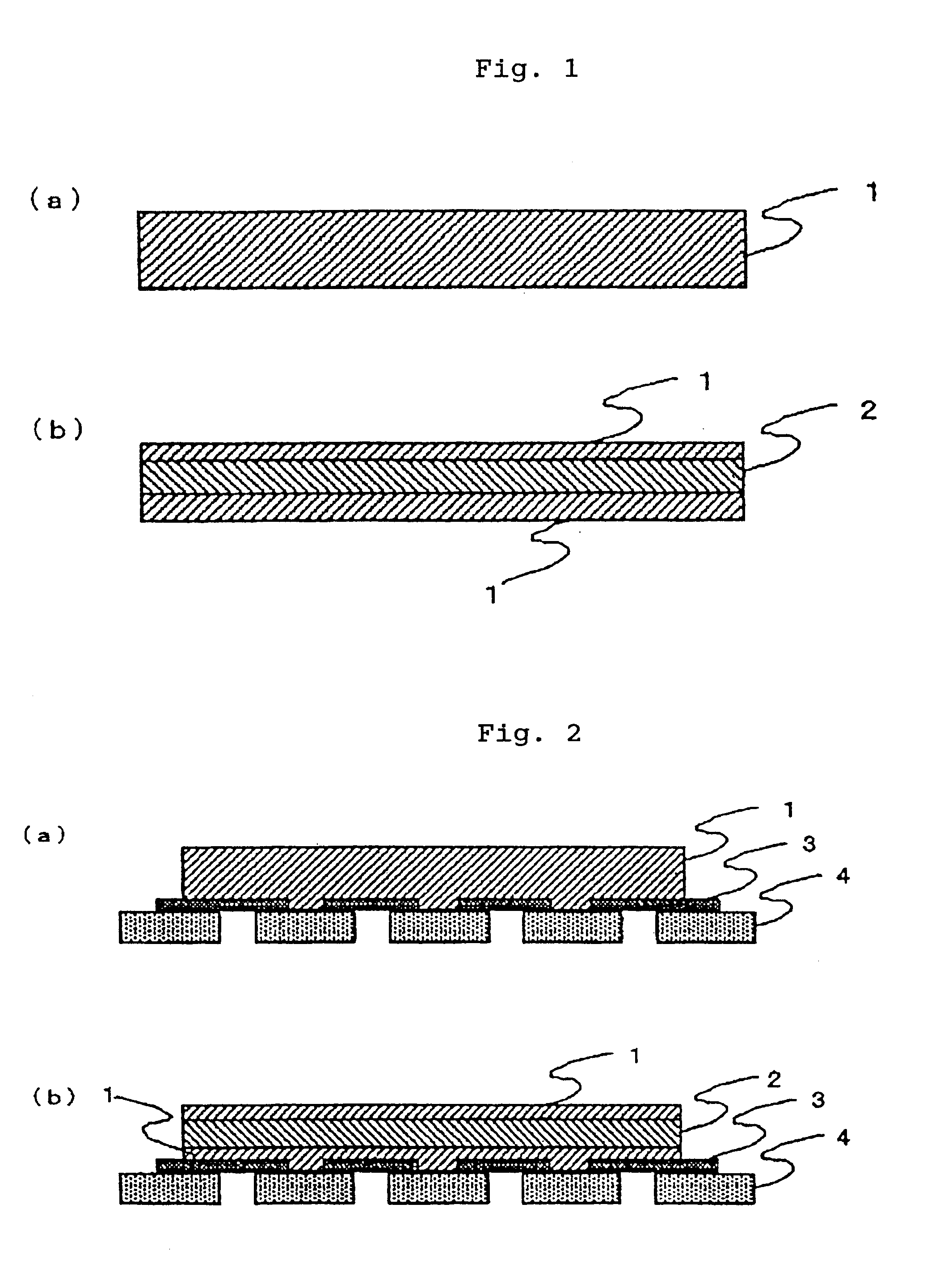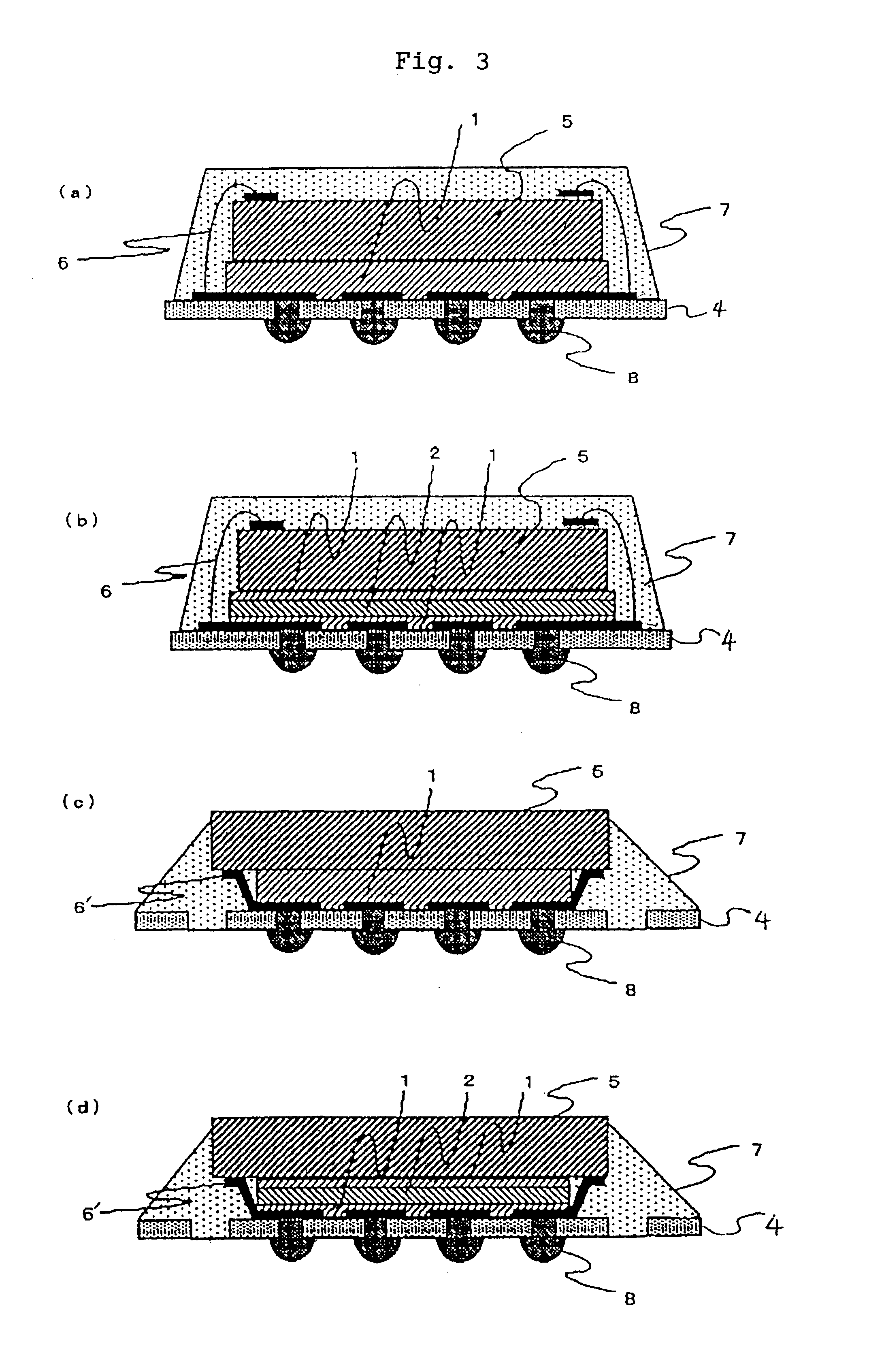Adhesive, adhesive member, interconnecting substrate for semiconductor mounting having adhesive member, and semiconductor device containing the same
a technology of adhesives and semiconductors, applied in the direction of film/foil adhesives, printed circuit assembling, synthetic resin layered products, etc., can solve the problems of deterioration of storage stability and large change in flowability, and achieve different coefficients of thermal expansion, low elasticity, and heat resistance
- Summary
- Abstract
- Description
- Claims
- Application Information
AI Technical Summary
Benefits of technology
Problems solved by technology
Method used
Image
Examples
example 1
An adhesive film bearing a carrier film was produced by applying adhesive varnish 1 onto a release-treated polyethyleneterephthalate film of 75 .mu.m thick and drying with heat at 140.degree. C. for 5 minutes to form a 75 .mu.m-thick coating of a B-stage state. Two sheets of the adhesive film were stuck together by using a hot roll laminator at a temperature of 110.degree. C., at a pressure of 0.3 MPa and at a rate of 0.3 m / min., to give an adhesive member in a form of a single-layer film of 150 .mu.m thick.
The curing degree of the adhesive in the above-described state was determined by using a DSC (a 912-type DSC produced by E. I. DuPont de Nemours and Company) (heating rate: 10.degree. C. / min.) to be such that it had generated 20% of the heat to be generated by complete curing. The residual solvent content of the adhesive alone was determined to be 1.5 wt. % based on the change in weight before and after heating at 120.degree. C. for 60 minutes.
example 2
An adhesive member in a form of a single-layer film was produced in the same manner as in Example 1, except that adhesive varnish 1 was replaced by adhesive varnish 2.
The curing degree of the adhesive in the above-described state was determined by using a DSC (a 912-type DSC produced by E. I. DuPont de Nemours and Company) (heating rate: 10.degree. C. / min.) to be such that it had generated 20% of the heat to be generated by complete curing. The residual solvent content was 1.4 wt. %.
example 3
Adhesive varnish 2 was applied onto a 25 .mu.m-thick polyimide film (trade name: UPILEX SGA-25 produced Ube Industries, Ltd.) and dried with heat at 120.degree. C. for 5 minutes to form a 50 .mu.m-thick coating of a B-stage state. The same varnish was then applied onto the polyimide film on the side bearing no adhesive layer and dried with heat at 140.degree. C. for 5 minutes to form a 70 .mu.m-thick coating of a B-stage state, to give an adhesive member comprising the polyimide film used as a core material bearing an adhesive layer on each side.
The curing degree of the adhesive in the above-described state was determined by using a DSC (a 912-type DSC produced by E. I. DuPont de Nemours and Company) (heating rate: 10.degree. C. / min.) to be such that it had generated in the 50 .mu.m-thick layer 25% of the heat to be generated by complete curing, and in the 75 .mu.m-thick layer, 20%. The adhesive in both layers had residual solvent contents of 1.3 to 1.6 wt. %.
PUM
| Property | Measurement | Unit |
|---|---|---|
| softening temperature | aaaaa | aaaaa |
| heat resistance | aaaaa | aaaaa |
| storage modulus | aaaaa | aaaaa |
Abstract
Description
Claims
Application Information
 Login to View More
Login to View More - R&D
- Intellectual Property
- Life Sciences
- Materials
- Tech Scout
- Unparalleled Data Quality
- Higher Quality Content
- 60% Fewer Hallucinations
Browse by: Latest US Patents, China's latest patents, Technical Efficacy Thesaurus, Application Domain, Technology Topic, Popular Technical Reports.
© 2025 PatSnap. All rights reserved.Legal|Privacy policy|Modern Slavery Act Transparency Statement|Sitemap|About US| Contact US: help@patsnap.com


